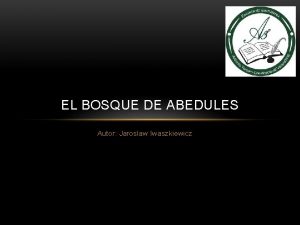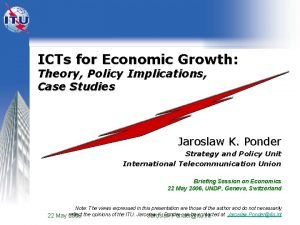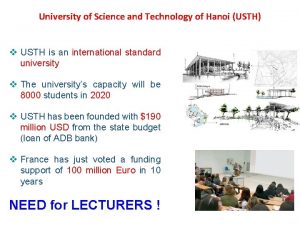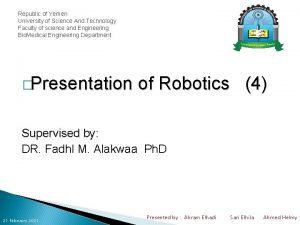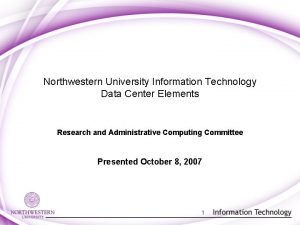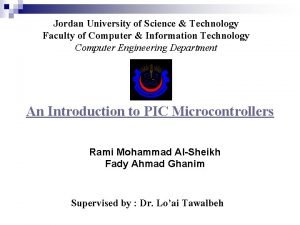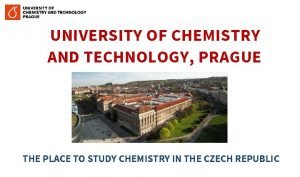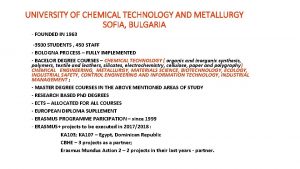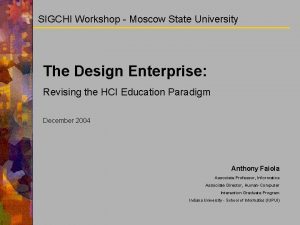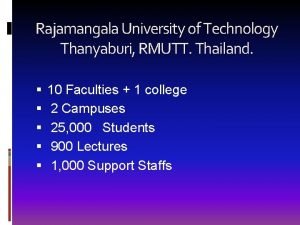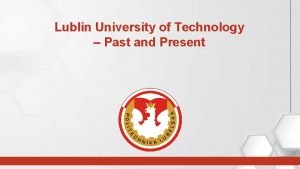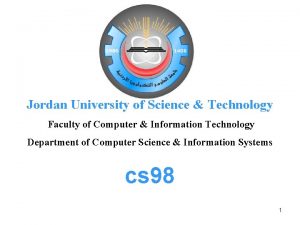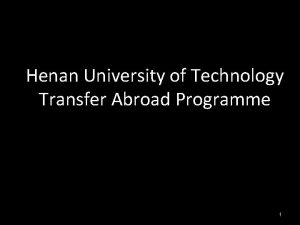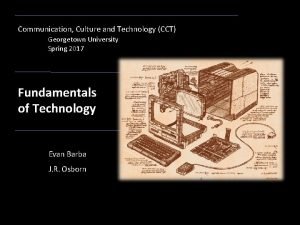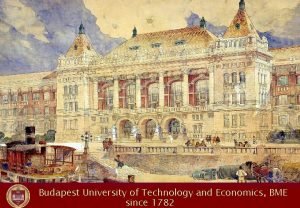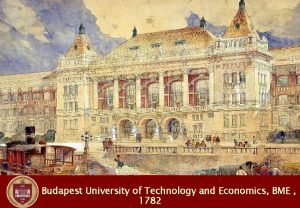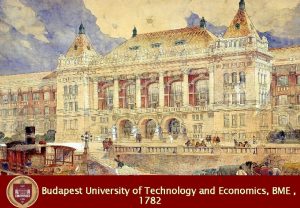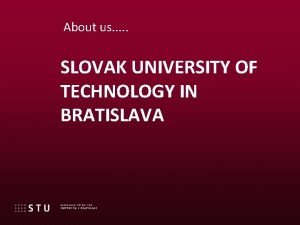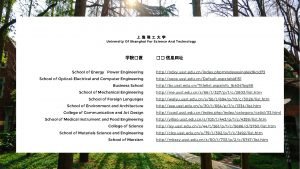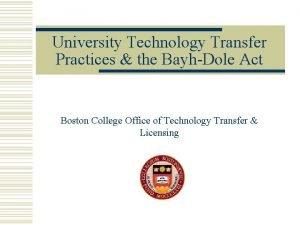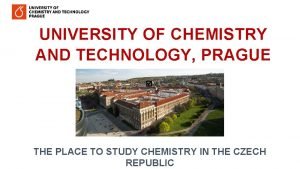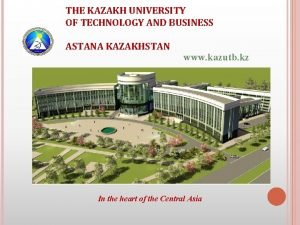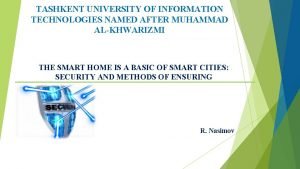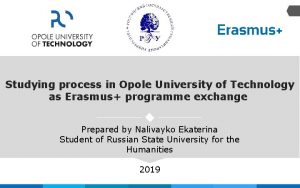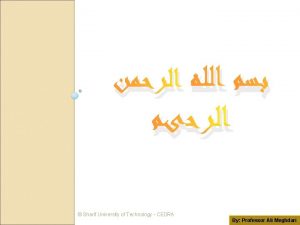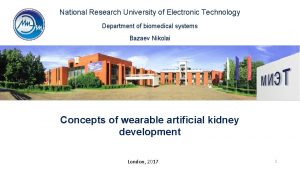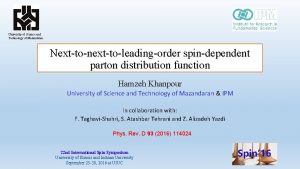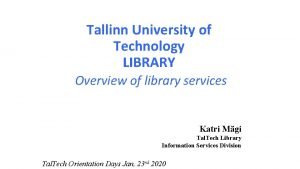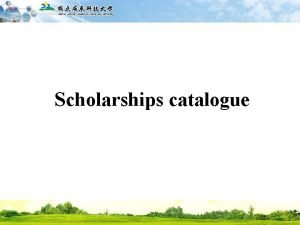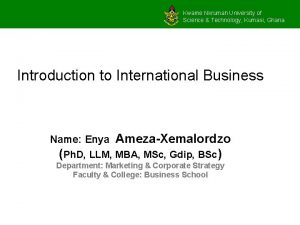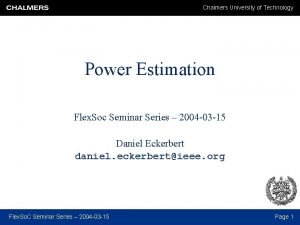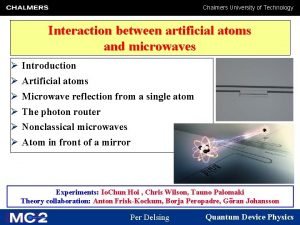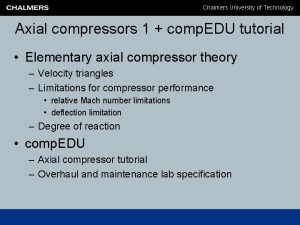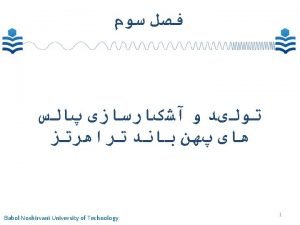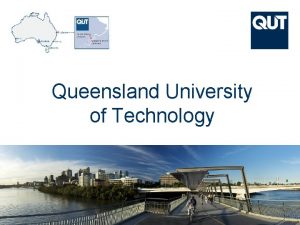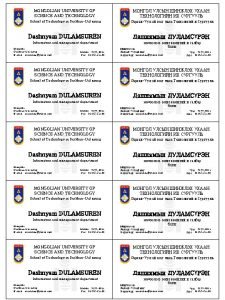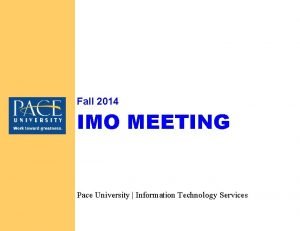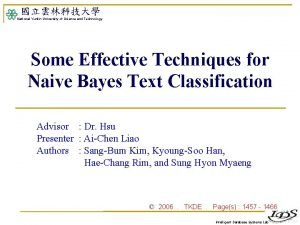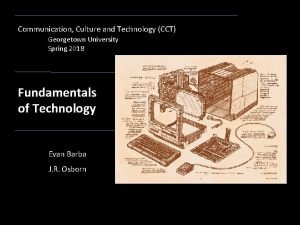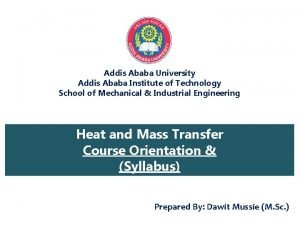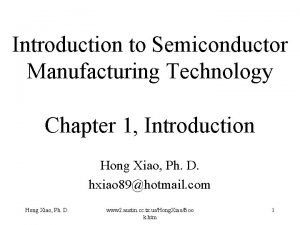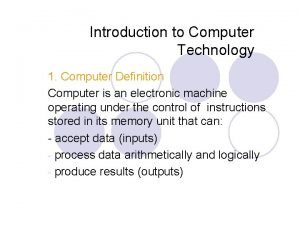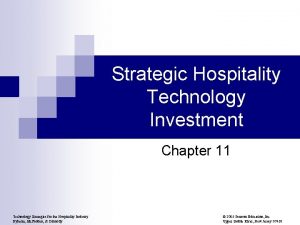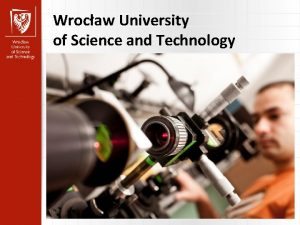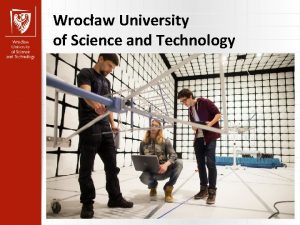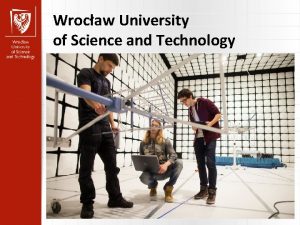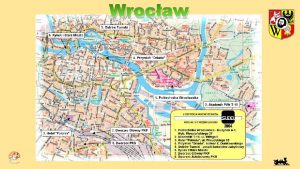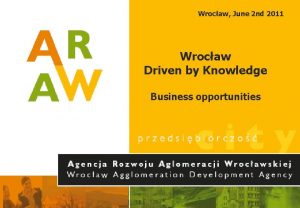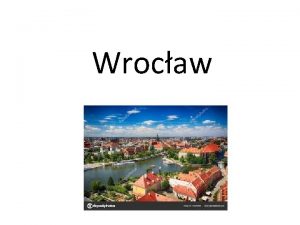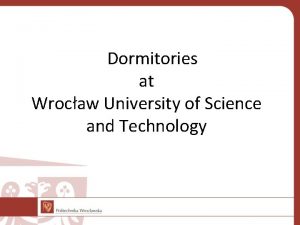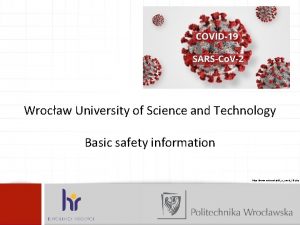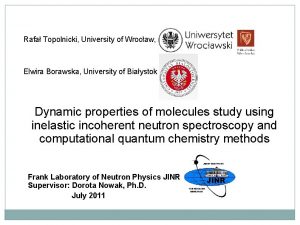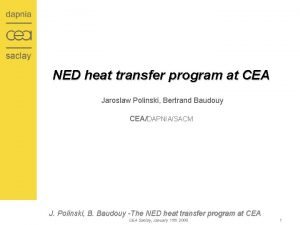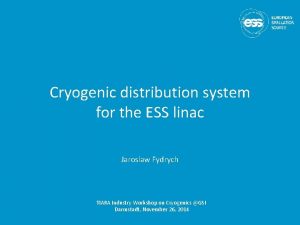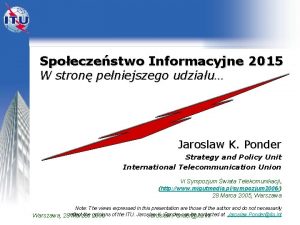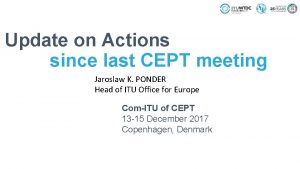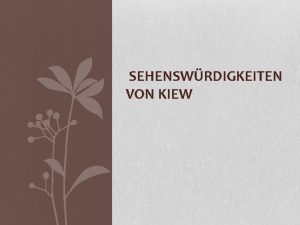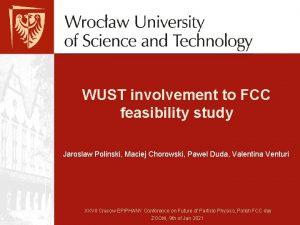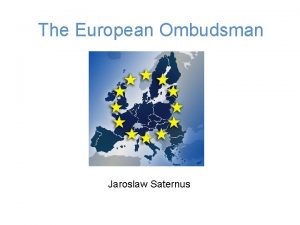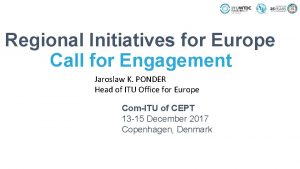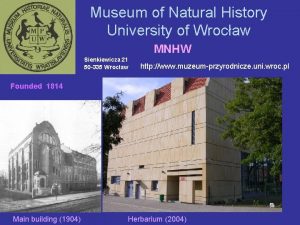Introduction to Wrocaw University of Technology Dr Jaroslaw






















































- Slides: 54

Introduction to Wrocław University of Technology Dr. Jaroslaw Polinski, Prof. Maciej Chorowski Faculty of Mechanical and Power Engineering Eu. CARD HFM collaboration meeting 24. 02. 09

Wrocław University of Technology • Employees Academicians – 1921 Administration – 2185 All: 4106 • Students 32800 • Degree programmes Bachelor of Sc. – 13, Master of Sc. – 25, Ph. D - 17

A little bit of history. • Wrocław University of Technology was founded in 1945. The group of 27 professors from University and Technical University in Lvov arrived to Wrocław and in the destroyed buildings of Technische Hochschule Breslau started Polish academic society. They brought here the academic tradition of Lvov and made sure that the achievements of Lvov University of Technology and Jan Kazimierz University were not lost. Our academic legacy of over 160 years entitles us to invoke the tradition of the European university and our position in the research and teaching field gives us the right to boast the title of the best technical university in Poland.

The first Polish lecture on the 15. XI. 45

Wroclaw University of technology - Faculties Faculty of Architecture Faculty of Civil Engineering Faculty of Chemistry Faculty of Electronics Faculty of Electrical Engineering Faculty of Geoengineering, Mining and Geology Faculty of Environmental Engineering Faculty of Computer Science and Management Faculty of Mechanical and Power Engineering Faculty of Mechanical Engineering Faculty of Fundamental Problems of Technology Faculty of Microsystem Electronics and Photonics

FACULTY OF MECHANICAL AND POWER ENGINEERING The Faculty of Mechanical and Power Engineering (W 9) was established 64 years ago, at the same time when Wroclaw University of Technology. Now there about 1600 students enrolled at the Faculty in 2006 and studying various aspects of mechanical sciences, basic and applied, in power engineering, thermal processes, avionics and refrigeration including cryogenics. An average number of about 150 students graduates each year, finding employment mostly related to power plants, modern industry and various services. The faculty staff consists of 25 professors, 55 doctors and 20 assistants. There are 70 doctoral students. All they are aided by 40 research technicians and engineering technicians.

FACULTY OF MECHANICAL AND POWER ENGINEERING - substructure • Institute of Power Engineering and Fluid Mechanics • Institute of Aviation, Processing and Power Machines Engineering

Faculty of Mechanical and Power Eng. Research areas: • Combustion and related fields – Combustion of fossil fuels – Biomass combustion and gasification – Environment protection, reduction of pollutant emission – Conversion of energy – Numerical simulation of flows and heat processes – Explosion capability and fire protection • Machine building and exploitation – – Construction and development of steam turbines Construction and development of steam boilers Refrigerators and cryocoolers Clearance and contact seals

Faculty of Mechanical and Power Eng. International cooperation: • • • European Organisation for Nuclear Research CERN in Geneva, CEA Saclay, France, Organisation for Applied Scientific Research, Netherlands, Inter University Accelerator Center, Delhi Technical University Clausthal, Germany, Technical University Munich, Germany, Technical University Dresden, Germany, Stuttgart University, Germany, University of Delft, Netherlands, University of Leeds, GB, Bristol University, GB, The students benefit from European student exchange programs SOCRATES, ERASMUS, LEONARDO.

PWR Cryogenic Group includes scientists from Wroclaw Univerity of Technology who are engaged in a number of activities and research into cryogenics.

Main Members of PWR Cryogenic Group Prof. Maciej CHOROWSKI - group leader Dr Jaroslaw FYDRYCH Dr Artur JEDRUSYNA Dr Tadeusz WISNIEWSKI Dr Janusz LICHOTA Dr Krzysztof TOMCZUK Dr Slawomir PIETROWICZ Dr Wojciech GIZICKI Dr Jaroslaw POLINSKI Dr Jacek KOSEK Agnieszka PIOTROWSKA - Ph. D stud. Michal STRYCHALSKI - Ph. D stud.

Main topics of competence • Design and commissioning of cryogenic installations including gas liquefiers • Risk and safety analysis of cryogenic systems • Reception tests of cryogenic installations • Pressure and helium tightness tests of cryogenic equipments • Superfluid helium cryostat designs and studies • Modeling and experimental investigation of cryogenic thermal insulation • Numerical investigation of cryogenic phenomena • Thermal and mechanical studies of cryogenic distribution lines • New materials in cryogenics

Risk and safety analysis of cryogenic systems Study on cold helium propagation in the LHC tunnel - PWR-CERN collaboration - performed in 2001 -2003 - aim: to describe teperature and oxygen concentration profiles in the tunnel during an unexpected cold helium discharge into the tunnel

Worst case scenario – quench with helium relieve Questions that were to be answered • Thermohydraulics of magnet resistive transitions • Pressure evolution in magnet cryostat following quench • Sector quench and helium relief • Helium potential flow to the LHC tunnel • And many others

Risk and safety analysis of cryogenic systems Test set-up build and operated at PWR Visualisation results LHe Air LHe 1 0. 8 0. 6 0. 4 0. 2 0 h/D Measurement results 0 5 10 15 20 O 2 concentration, % 1 0. 8 0. 6 0. 4 0. 2 0 180 200 220 240 260 280 300 Temperature, K

Risk and safety analysis of cryogenic systems Cold helium propagation in the LHC tunnel Large scale experiment at CERN

Risk and safety analysis of cryogenic systems Study on helium safety reliefe system for DPS 2 -F cryostat of the Karlsruhe Tritium Neutrino Experiment - PWR-Forschungszentrum Karlsruhe collaboration - performed in 2005 - aims: ● to analyse of some potential scenarios that can lead to the helium relieve from the cryostat to the atmosphere; ● to specify potential flow through the bursting disk and safety valve;

Risk and safety analysis of cryogenic systems Heat flux to the helium after air venting to the insulation vacuum space Scheme of the DPS 2 cryostat and its safety system The evolutions of helium mass in the cryostat and helium mass outflow

Reception tests of cryogenic systems Reception test of the LHC Cryogenic Distribution Line in sector 7 -8 (sub-sectors A and B) Reception test of the LHC Cryogenic Distribution Line in sector 8 -1 - PWR-CERN collaboration - performed in 2005 -2006 - aims: ● to verify overal behaviour of the line at cryogenic temperatures; ● to measure heat inleaks to the circuts 4. 5 -20 K and 50 -80 K

Reception tests of cryogenic systems 3. 3 km circuit 4. 5 -20 K, circuit 50 -80 K Configuration of the LHC Cryogenic Distribution Line in sector 8 -1 for the reception test

Reception tests of cryogenic systems Measured heat inleaks to circuit 50 -80 K Heat inleak 11 -Dec 8818 W 12 -Dec 9007 W 13 -Dec 8920 W Measured heat inleaks to circuit 4. 5 -20 K Heat inleak Temperature evolutions of the Cryogenic Distribution Line main headers during the reception test in sector 8 -1 with JR without JR 11 -Dec 633. 3 W 603. 9 W 12 -Dec 632. 9 W 582. 3 W 13 -Dec 635. 1 W 572. 5 W

Reception tests of cryogenic systems Some members of PWR cryogenic grup in the LHC tunnel The LHC Cryogenic Distribution Line during the reception tests in sector 8 -1

Stability tests of QRL bellows, commissioning of the LHC Stability tests of some bellows types for Cryognic Distribution Line were performed at PWR in 2006

Pressure and leak tightness tests of cryogenic equipments Pressure and leak tightness tests of the LHC Cryogenic Electrical Feedboxes - PWR-CERN collaboration - performed in 2006 -2007 - aim: to verify high pressure resistance and leak tightness and to measure residual leaks (at the level below 1 10 -9 mbar l/s)

Pressure and leak tightness tests of cryogenic equipments Cryogenic Electrical Feedboxes for the LHC Sh uff lin ~3 g b m ox Hi gh C ~8 urr en t M m od ule Lo w Cu rre nt ~7 Mo m du le

Pressure and leak tightness tests of cryogenic equipments Low Current Module of Cryogenic Electrical Feedbox under pressure and helium leak tightness test

Pressure and leak tightness tests of cryogenic equipments High Current Module of the Cryogenic Electrical Feedbox (DFBAC) during preparation for the pressure and helium leak tightness test

Superfluid helium cryostat designs and studies Superfluid helium cryostat for Next European Dipole project - PWR participation in CARE (FP 6 project) - performed in 2004 -2005 - aim: designing, construction and study on the He II cryostat to perform measurements in low temperature conditions

Superfluid helium cryostat designs and studies Next European Dipol cryostat

Superfluid helium cryostat designs and studies 2 4 1 5 3 CARE-NED cryostat experimental set-up in CEA Saclay, 1 – Cryostat NED 2 – Cryostat insert 3 – Instrumentation 4 – Pumping and recovery line 5 – Liquid helium dewar Temperatute evolution during the first cryostat cool-down

Superfluid helium cryostat designs and studies Superfluid helium cryostat for the measurement of heat transfer in He II - PWR-CERN collaboration - performed in 2005 -2007 - aim: to measure and obtain heat transfer coefficients in superfluid, saturated and supercritical helium

Superfluid helium cryostat designs and studies Scheme of pressurized superfluid helium cryostat

Superfluid helium cryostat designs and studies Measurement vessel with instrumentation External vacuum jacet during leak test Radiation screen with MLI

Measurements of the heat transfer through SC cable electrical insulation in He IIp Scheme of the measurement method Measurement apparatus with instrumentation

Modeling and experimental investigation of cryogenic thermal insulation - PWR - performed in 2005 -2007 - aims: ● development of some mathematical models of heat transfer through cryogenic insulations; ● computer implementation of the model as a tool for cryogenic insulation designing; ● experimental determination of the heat flux thought different cryogenic insulations;

Modeling and experimental investigation of cryogenic thermal insulation Multilayer Insulation (MLI) heat transfer scheme and mathematical modeling Set of equations: Solid heat conduction: Residual gas heat conduction: Heat radiation:

Modeling and experimental investigation of cryogenic thermal insulation Computer implementation of MLI mathematical model Program inputs: • • • Number of layers Layer density Residual gas type (N 2/ Air, He, H 2) Residual gas pressure Temperature of the warm and cold boundaries Distance between boundaries Boundary materials emissivity MLI configuration (MLI blanket wound on warm/cold boundary) Radiation shield emissivity Spacer thermal conductivity coefficient

Modeling and experimental investigation of cryogenic thermal insulation Cryostat to perform tests of heat transfer through cryogenic insulation Experiment setup: 1 – measurement cryostat; 2 – turbopump; 3 – flow counter; 4 – vacuum pressure monitoring; 5 – temperature monitoring; 6 – active cooled shield temperature regulator; 7 – storage data computer

Numerical investigation of cryogenic phenomena Numerical modelling of heat transfer between superconduting magnet structure and helium -PWR-CERN collaboration - performed in 2006 -2007 - aim: to analyse heat transfer and helium flow from the magnet structure to the helium after resistive transition and in ultimate conditions (FEM, ANSYS ICEM and ANSYS CFX software)

Numerical investigation of cryogenic phenomena Test banch of the STRING 2 experiment Bulk helium parameter evolutions after the simultaneous resistive transition of the STRING 2 magnets

Example of numerical calculation a). Pictorial view of simplified geometry of numerical calculations with the selected points of the collar b) Evolution of the temperature in the fin Animation of evolution of temperature in the fin

Numerical investigation of cryogenic phenomena Symmetry Adiabatic wall The wall at constant temperature or heat flux Helium I at 4. 5 K Geometry, boundary conditions and mesh for numerical calculation of the MQY magnet

Thermal and mechanical studies of cryogenic distribution lines - PWR- ITER collaboration - performed in 2008 - aim: thermal and mechanical analysis of the sections of cryogenic lines for torus and cryostat cryopumps of ITER

Thermal and mechanical studies of cryogenic distribution lines Mesh Deformation – weight, pressure and thermal loads Temperature distribution Heat flux distribution

Thermal and mechanical studies of cryogenic distribution lines Pipe model Node location on the model Stress computation results

Development of Ag alloys for BSCCO tape sheaths - PWR - performed in 2005 -2007 - aims: development of the new silver alloys for BSCCO tape with improved diffusion coefficient and with respect of mechanical and thermal properties;

Development of Ag alloys for BSCCO tape sheaths

BSCCO tapes manufacturing (IFW Dresden) 20 mm BSCCO/Ag/Ag-Mg BSCCO/Ag/Ag-Sn BSCCO/Ag/Ag-Cu-Zr BSCCO/Ag/Ag-Cu-Ni

Thermal conductivity of sheath material – state after oxidation at 830°C/30 h

Connections with Industry PWR Cryogenic Group has well established relationship with Polish industry, including small and big companies (for example: Rafako, Kriosystem, Wroclaw Technological Park, etc. )

Example of RAFAKO cryo-products Section of the STRING 1 and 2 test-rig

Example of KRIOSYSTEM products Liquid nitrogen and liquid helium transfer lines

Example of KRIOSYSTEM products Helium II cryostats

Summary • PWR – University with over 160 years of tradition, 12 technical faculties, 2000 scientific stuff, more then 30. 000 students • The Faculty of Mechanical and Power Engineering (W 9) – 64 years of tradition, 25 professors, 55 doctors , 20 assistants and 70 Ph. D students; Main subjects: basic and applied mechanical sciences in power engineering, thermal processes, avionics and refrigeration including cryogenics • PWR Cryogenic Group – some years of tradition, 12 scientific stuff, strong experience in thermal and mechanical modeling, cryogenic devices designing, safety of the cryogenic systems analysis, process control and electronics, cooperation with international scientific centers and Polish industry
 Jaroslaw iwaszkiewicz
Jaroslaw iwaszkiewicz Jaroslaw ponder
Jaroslaw ponder Outlook hust
Outlook hust Unist ulsan national institute of science and technology
Unist ulsan national institute of science and technology The university of science and technology yemen
The university of science and technology yemen Northwestern university information technology
Northwestern university information technology Jordan university of science and technology
Jordan university of science and technology Jordan university of science and technology
Jordan university of science and technology University of chemistry and technology in prague
University of chemistry and technology in prague University of chemical technology and metallurgy
University of chemical technology and metallurgy Eindhoven university of technology
Eindhoven university of technology Moscow state university of design and technology
Moscow state university of design and technology Eoffice rmutt
Eoffice rmutt Lublin university of technology notable alumni
Lublin university of technology notable alumni Jordan university of science and technology
Jordan university of science and technology Henan university of technology (haut)
Henan university of technology (haut) Georgetown university communication culture and technology
Georgetown university communication culture and technology Neptun bme hu
Neptun bme hu Budapest university of technology and economics
Budapest university of technology and economics Bme 1782
Bme 1782 Slovak university of technology in bratislava
Slovak university of technology in bratislava University of shanghai for science and technology
University of shanghai for science and technology Boston university technology transfer
Boston university technology transfer Uct prague accommodation
Uct prague accommodation Kazakh university of technology and business
Kazakh university of technology and business Tashkent university of information technology
Tashkent university of information technology Opole university of technology erasmus
Opole university of technology erasmus Sharif university of technology
Sharif university of technology Pec university of technology
Pec university of technology National research university of electronic technology
National research university of electronic technology Amirkabir university of technology logo
Amirkabir university of technology logo Amirkabir university of technology logo
Amirkabir university of technology logo University of science and technology of mazandaran
University of science and technology of mazandaran Taltech uni id
Taltech uni id Pingtung university of science and technology
Pingtung university of science and technology Military university of technology
Military university of technology University of science and technology kumasi
University of science and technology kumasi Chalmers university of technology
Chalmers university of technology Chalmers university of technology
Chalmers university of technology Chalmers university of technology
Chalmers university of technology Noshirvani university of technology
Noshirvani university of technology Queensland university of technology
Queensland university of technology Mongolian university of science and technology logo
Mongolian university of science and technology logo Pace university information technology
Pace university information technology National yunlin university of science and technology
National yunlin university of science and technology Georgetown university communication culture and technology
Georgetown university communication culture and technology Cct georgetown
Cct georgetown Addis ababa university institute of technology
Addis ababa university institute of technology 沈榮麟
沈榮麟 Touch screen introduction
Touch screen introduction Plt 403
Plt 403 Shallow trench isolation
Shallow trench isolation Computer technology introduction
Computer technology introduction Information technology introduction
Information technology introduction Introduction to strategic hospitality technology investment
Introduction to strategic hospitality technology investment
